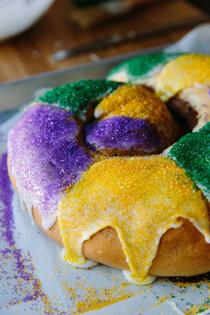The Kitchn: How to make a king cake for Mardi Gras
King cakes are named for the Three Kings of the Bible and were part of the Epiphany celebration at the end of the 12 Days of Christmas. They're variously called Galette des Rois in France, Rosca de Reyes in Spain, and vasilopita in Greece.
I spoke with Judy Walker, retired food editor for the New Orlean's Times-Picayune and author of "Cooking Up a Storm," about how the king cake tradition has taken shape in Louisiana. She told me that it was originally brought to the area by French settlers, but it wasn't until the 20th century that the cakes really took firm hold.
Two local bakeries, McKenzie's and Gambino's, were key in establishing the cultural significance of the king cakes. They started selling their versions of king cake during Carnival season, and the popularity just skyrocketed. Walker told me that king cakes from New Orleans' bakeries are now shipped all over the world, and it's become a major industry in the area.
What's with the baby?
Traditionally, the "baby" was actually a small dried bean or a pecan, which would get baked right into the cake. Finding the bean in your slice of cake means that you got to be king or queen for the day, and you are also responsible for bringing the next cake to keep the party going. (If you're in New Orleans, don't overlook this etiquette of bringing the next cake or you may find yourself with grumpy co-workers!)
Since then, the bean has morphed into an actual toy baby figurine -- although Walker was quick to stop me when I mused that this must represent the baby Jesus. She said that all sorts of trinkets have been used in king cakes, and the baby figurine is just one that caught on particularly well.
King cakes every which way
New Orleans king cakes take after the Southern French tradition of a ring-shaped cake made with a rich yeasted bread similar to brioche, but as Walker explained to me, there is a lot of room for the individual baker's tastes and interpretation. Yes, the very original kings cake were fairly plain yeasted loaves, included no filling, and were barely sweet, but they have evolved with the times and with people's tastes.
These days, you can find -- or make! -- king cakes that are filled or unfilled, shaped in a plain circle or twisted into a braid, and topped with plain icing or covered with glittering sprinkles on every surface. The most popular versions are stuffed with a cream cheese filling or with a cinnamon filling, but Walker also talked about seeing king cakes filled with everything from pecan praline to goat cheese and apples. Walker says, "People like their own styles and often have loyalties to a particular bakery."
Our recipe for king cake
The particular king cake that I made for this recipe is adapted from Walker's own recipe in "Cooking Up a Storm." I took her advice on the filling and stuck with cinnamon and sugar -- my favorite -- and rolled it up like one giant cinnamon roll. I love the pretty spiraled layers this makes. If you'd like a more sweet and doughy bread with less filling than we've made here, just roll your dough more thinly and make fewer rolls.
King Cake for Mardi Gras
Makes 1 large cake
Adapted from "Cooking Up a Storm: Recipes Lost and Found from The Times-Picayune of New Orleans"
For the cake:
1/4 cup water
2 teaspoons active-dry yeast
1/2 cup (1 stick) unsalted butter, very soft
1/4 cup whole or 2% milk
2 large eggs, lightly whisked
2 tablespoons sugar
1/4 teaspoon ground nutmeg
1/2 teaspoon salt
3 to 3 1/2 cups all-purpose flour
For the cinnamon filling:
4 tablespoons unsalted butter, softened
2/3 cup packed light brown sugar
1 1/2 teaspoons ground cinnamon
1 dried red bean or half a pecan
To decorate the cake:
1 cup powdered sugar, sifted
1/4 teaspoon almond extract
2 tablespoons whole or 2% milk
Purple, green, and yellow paste food coloring (or other colors depending upon the occasion)
Purple, green, and yellow sprinkles
Equipment:
Stand mixer, or large mixing bowl if kneading by hand
Rolling pin
Spatula
Pastry scraper
Baking sheet
Parchment
Cooling rack
Small mixing bowls, for mixing the icing
Mix the dough: Combine the water and yeast in the bowl of a stand mixer and let it dissolve. Stir in the softened butter, milk, eggs, sugar, nutmeg and salt. Add 3 cups of flour and stir to form a shaggy dough. Reserve the remaining 1/2 cup of flour.
Knead the dough: Using the dough hook attachment, begin kneading the dough on low speed. Continue kneading the dough until all the loose flour has been worked in, the dough comes together in a ball, and it feels smooth and elastic, 5 to 7 minutes. It will feel a bit more dense and malleable than regular bread dough -- more like play dough. Alternatively, turn the dough out on a lightly floured counter and knead by hand for about 10 minutes. If the dough sticks to the bowl, the hook, or your hands, add a little of the reserved flour.
Let the dough rise: Clean the bowl used to mix the dough and film it lightly with vegetable oil. Shape the dough into a ball with your hands, set it in the bowl, and cover. Place the bowl somewhere warm and let the dough rise until doubled in bulk, about 1 hour.
Roll the dough into a rectangle: Once the dough has doubled in bulk, scrape it out onto a lightly floured counter. Pat it into a rough rectangular shape using floured hands, then use a rolling pin to roll the dough into a fairly thin rectangle roughly 24 inches wide by 10 inches tall.
Spread the filling over the dough: Use a spatula to spread the butter in a thin layer all over the dough. Leave 1/2 inch of clear space at the top of the rectangle. Whisk together the sugar and cinnamon, then sprinkle it evenly over the butter. Press lightly with the palms of your hands or the rolling pin to help the sugar stick to the butter.
Hide the bean: Place the dried red bean or pecan half somewhere on the surface of the dough; it will be hidden once you roll up the dough.
Roll up the dough: Starting at the long end closest to you, roll the dough up toward the top. A pastry scraper can help with this step if your dough sticks. Pinch the log of dough closed and roll it over onto the seam.
Coil the log into a circle: Curl the log of dough into a ring and overlap the ends slightly so that the ring is the same height all around. Pinch the dough lightly where the ends overlap so they form a seal. Transfer the round to a baking sheet lined with parchment.
Let the dough rise: Drape the dough loosely with plastic wrap. Let it rise at room temperature until it looks puffed and slightly larger, 45 to 60 minutes.
Preheat the oven to 350 F halfway through the dough rising.
Bake the king cake: Bake until lightly browned and golden on top, 30 to 40 minutes. A little syrupy filling might ooze onto the baking sheet; this is normal.
Cool the cake: Let the cake cool for a few minutes on the baking sheet, then transfer the cake to a cooling rack. Let it cool completely to room temperature.
Prepare the icing: Mix together the powdered sugar, almond extract and 2 tablespoons of milk in a small bowl to create a thick, but pourable, icing. Add 1/2 tablespoon more milk as needed to adjust the consistency. Leave the icing white if you're decorating the cake with colored sprinkles, or divide the icing into three bowls and tint each one a different color with food dyes.
Decorate the cake: Drizzle the frosting over the cake in patches of different color, letting some icing drizzle down the sides. "Paint" the cake with as many different patches or strips as you like. Cover with colored sprinkles, if you like.
Store or serve: This cake is best served within a day or two of making it. Let the icing dry completely, then loosely cover with plastic and store at room temperature -- avoid the plastic touching the icing as much as possible, or wait to frost until just before serving. The sliced cake or leftovers should be kept in an airtight container at room temperature.
Recipe notes: Let the cake cool completely, then wrap in a double layer of plastic wrap and foil. Do not add the icing. Freeze for up to three months. Thaw overnight on the counter, then frost before serving.
If you're using a plastic baby figurine in your cake, wait until after the cake is baked to add it. Once out of the oven, lift up the cake and gently push the baby into the underside of the cake so that it's hidden.
(Emma Christensen is a contributor to TheKitchn.com, a nationally known blog for people who love food and home cooking. Submit any comments or questions to editorial@thekitchn.com.)







